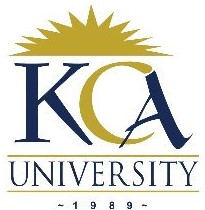 UNIVERSITY EXAMINATIONS: 2017/2018
UNIVERSITY EXAMINATIONS: 2017/2018
EXAMINATION FOR THE DEGREE OF BACHELOR OF SCIENCE IN
INFORMATION TECHNOLOGY/BACHELOR OF SCIENCE IN
INFORMATION AND COMMUNICATIONS TECHNOLOGY/BACHELOR
OF SCIENCE IN APPLIED COMPUTING
BIT 2311/BCT 2102BAC 2501: NETWORK SYSTEMS DESIGN AND
MANAGEMENT
FULL TIME/PART TIME
DATE: AUGUST, 2018 TIME: 2 HOURS
INSTRUCTIONS: Answer Question One & ANY OTHER TWO questions.
QUESTION ONE [30 MARKS]
a) Study the diagram below.
(i) Based on the diagram shown above, what kind of cable should be used to make
each connection that is identified by the numbers shown? Explain 4 Marks
(ii) What kind of cable should be used to establish a trunked line between two
Catalyst switches? 1 Mark
b) The convergence of the many different communication media onto a single network
platform is fueling exponential growth in network capabilities. There are three major trends that
are contributing to the future shape of complex information networks. Discuss. 6 Marks
c) Discuss the stages involved when gathering symptoms for a network problem.
5 Marks
d) The KCAU corporate LAN consists of one large flat network. You decide to segment this
LAN into two separate networks with a router.
(i) What will be the affect of this change? 2 Marks
(ii) If a host on a network has the address 192.168.10.40/28, what is the address of the
subnetwork to which this host belongs? 2 Marks
(iii) How many hosts per subnet have been created by the addressing scheme above?
2 Marks
e) When planning the installation of LAN cabling, there are physical areas to consider.
Discuss each of the following areas:
(i) Work Areas 4 Marks
(ii) Telecommunications Room 4 Mark
QUESTION TWO [20 MARKS]
a) Discuss the benefits that have necessitated the development of the teleworker solution.
6 Marks
b) Describe the functions of the following hardware troubleshooting tools:
(i) Cable analyzers 2 Marks
(ii) Portable Network Analyzers 2 Marks
c) After you have determined the location of all of the network devices, you are ready to
install the network cables. If you are going to install the cable yourself, all of the necessary
materials should be available at the site, as well as a blueprint of the network’s physical topology.
Outline the process for physically creating a network. 7 Marks
d) What factors would you take into account when choosing between a layer 3 switch and a
router? 3 Marks
QUESTION THREE [20 MARKS]
a) Describe any four major benefits associated with hierarchical network designs.
8 Marks
b) Explain any six ways that network managers can enhance availability and reliability of
their networks. 6 Marks
c) Explain any three costs that can be attributed to poor cabling 6 Marks
QUESTION FOUR [20 MARKS]
a) Discuss the guidelines for choosing the right troubleshooting methodology.
4 Marks
b) Discuss the following in relation to switches:
(i) Port security 2 Marks
(ii) Power over Ethernet (PoE) 2 Marks
(iii) Link aggregation 2 Marks
c) WANs are groups of LANs connected together with communications links from a service
provider. Because the communications links cannot plug directly into the LAN, it is
necessary to identify the various pieces of interfacing equipment. Describe the functions
of the following WAN devices:
(i) Router 2 Marks
(ii) CSU/DSU 2 Marks
(iii) Modem 2 Marks
(iv) Communication server 2 Marks
d) Differentiate between cut-through switching and store-and-forward switching.
2 Marks
QUESTION FIVE [20 MARKS]
a) A network may require an upgrade to one of the faster Ethernet topologies. Most Ethernet
networks support speeds of 10 Mbps and 100 Mbps. The new generation of multimedia,
imaging, and database products can easily overwhelm a network that operates at
traditional Ethernet speeds of 10 and 100 Mbps. Network administrators may choose to
provide Gigabit Ethernet from the backbone to the end user. Describe how Ethernet
technologies can be used economically in a campus network. 6 Marks
b) Outline any three objectives to be followed when conducting network continuity
planning in order to avoid superfluous or unwanted outcomes. 6 Marks
c) Discuss the following concepts as used in LANs:
(i) Symmetric Switching 2 Marks
(ii) Asymmetric Switching 2 Marks
d) Explain any four routing metrics used by routing protocols to determine the best path for
a packet. 4 Marks
